Principles of Leadership and Management: Unit 73 Report Analysis
VerifiedAdded on 2023/01/11
|10
|2767
|64
Report
AI Summary
This report provides a comprehensive analysis of leadership and management principles, focusing on decision-making processes, the influence of managers and leaders, and the application of different leadership styles. It explores motivational theories and their practical implementation in the workplace, alongside the responsibilities of managers in planning, coordinating, and controlling work. The report examines how managers ensure team objectives are met and contribute to organizational vision, mission, and objectives. It also delves into management theories and models, operational constraints imposed by budgets, the relationship between business objectives and performance measures, and the features of performance measurement systems, including the setting of key performance indicators (KPIs) and monitoring and reporting on business performance. The report concludes with a discussion on the distinction between outcomes and outputs within the context of performance management.

Unit 73: Principles of
Leadership and Management
Leadership and Management
Paraphrase This Document
Need a fresh take? Get an instant paraphrase of this document with our AI Paraphraser
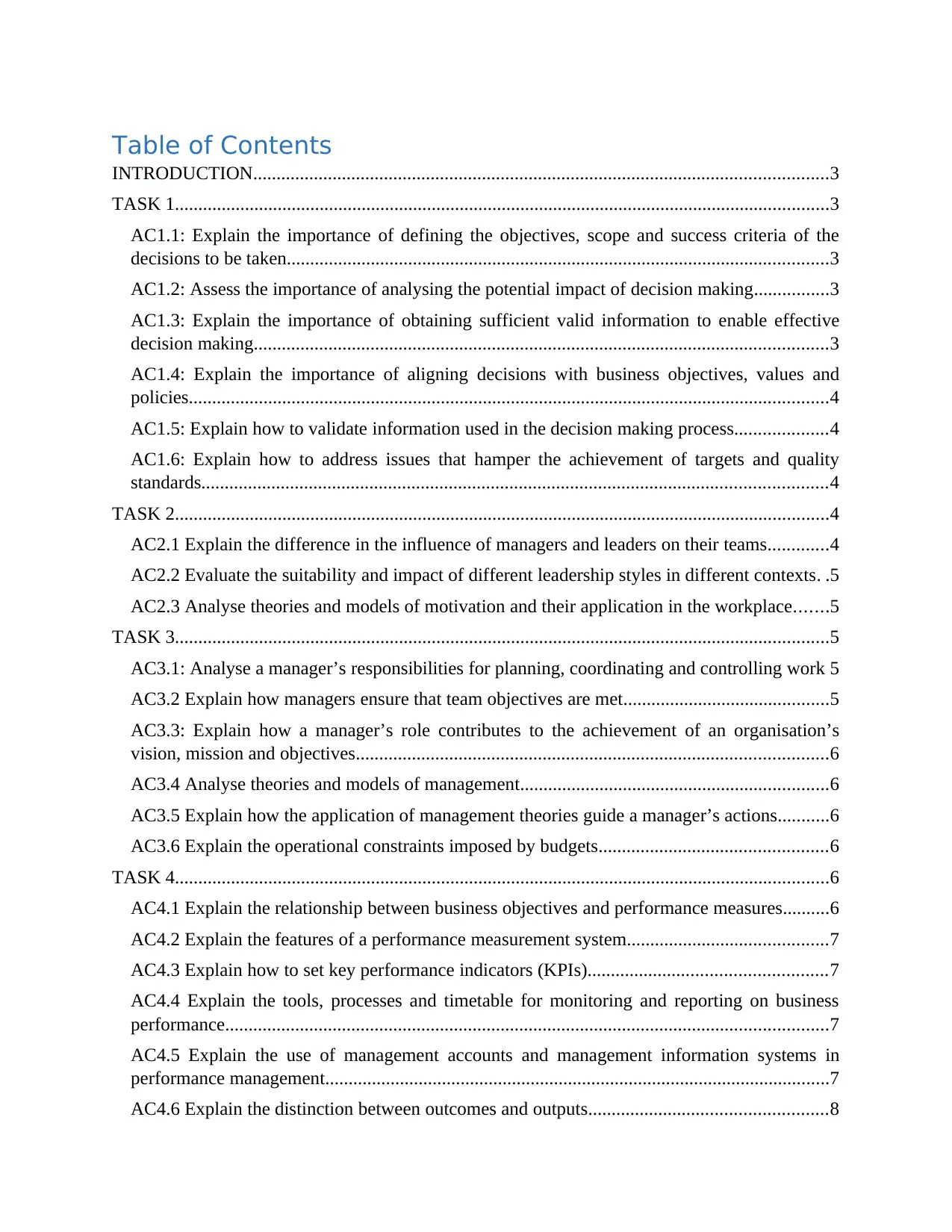
Table of Contents
INTRODUCTION...........................................................................................................................3
TASK 1............................................................................................................................................3
AC1.1: Explain the importance of defining the objectives, scope and success criteria of the
decisions to be taken....................................................................................................................3
AC1.2: Assess the importance of analysing the potential impact of decision making................3
AC1.3: Explain the importance of obtaining sufficient valid information to enable effective
decision making...........................................................................................................................3
AC1.4: Explain the importance of aligning decisions with business objectives, values and
policies.........................................................................................................................................4
AC1.5: Explain how to validate information used in the decision making process....................4
AC1.6: Explain how to address issues that hamper the achievement of targets and quality
standards......................................................................................................................................4
TASK 2............................................................................................................................................4
AC2.1 Explain the difference in the influence of managers and leaders on their teams.............4
AC2.2 Evaluate the suitability and impact of different leadership styles in different contexts. .5
AC2.3 Analyse theories and models of motivation and their application in the workplace.......5
TASK 3............................................................................................................................................5
AC3.1: Analyse a manager’s responsibilities for planning, coordinating and controlling work 5
AC3.2 Explain how managers ensure that team objectives are met............................................5
AC3.3: Explain how a manager’s role contributes to the achievement of an organisation’s
vision, mission and objectives.....................................................................................................6
AC3.4 Analyse theories and models of management..................................................................6
AC3.5 Explain how the application of management theories guide a manager’s actions...........6
AC3.6 Explain the operational constraints imposed by budgets.................................................6
TASK 4............................................................................................................................................6
AC4.1 Explain the relationship between business objectives and performance measures..........6
AC4.2 Explain the features of a performance measurement system...........................................7
AC4.3 Explain how to set key performance indicators (KPIs)...................................................7
AC4.4 Explain the tools, processes and timetable for monitoring and reporting on business
performance.................................................................................................................................7
AC4.5 Explain the use of management accounts and management information systems in
performance management............................................................................................................7
AC4.6 Explain the distinction between outcomes and outputs...................................................8
INTRODUCTION...........................................................................................................................3
TASK 1............................................................................................................................................3
AC1.1: Explain the importance of defining the objectives, scope and success criteria of the
decisions to be taken....................................................................................................................3
AC1.2: Assess the importance of analysing the potential impact of decision making................3
AC1.3: Explain the importance of obtaining sufficient valid information to enable effective
decision making...........................................................................................................................3
AC1.4: Explain the importance of aligning decisions with business objectives, values and
policies.........................................................................................................................................4
AC1.5: Explain how to validate information used in the decision making process....................4
AC1.6: Explain how to address issues that hamper the achievement of targets and quality
standards......................................................................................................................................4
TASK 2............................................................................................................................................4
AC2.1 Explain the difference in the influence of managers and leaders on their teams.............4
AC2.2 Evaluate the suitability and impact of different leadership styles in different contexts. .5
AC2.3 Analyse theories and models of motivation and their application in the workplace.......5
TASK 3............................................................................................................................................5
AC3.1: Analyse a manager’s responsibilities for planning, coordinating and controlling work 5
AC3.2 Explain how managers ensure that team objectives are met............................................5
AC3.3: Explain how a manager’s role contributes to the achievement of an organisation’s
vision, mission and objectives.....................................................................................................6
AC3.4 Analyse theories and models of management..................................................................6
AC3.5 Explain how the application of management theories guide a manager’s actions...........6
AC3.6 Explain the operational constraints imposed by budgets.................................................6
TASK 4............................................................................................................................................6
AC4.1 Explain the relationship between business objectives and performance measures..........6
AC4.2 Explain the features of a performance measurement system...........................................7
AC4.3 Explain how to set key performance indicators (KPIs)...................................................7
AC4.4 Explain the tools, processes and timetable for monitoring and reporting on business
performance.................................................................................................................................7
AC4.5 Explain the use of management accounts and management information systems in
performance management............................................................................................................7
AC4.6 Explain the distinction between outcomes and outputs...................................................8

CONCLUSION................................................................................................................................8
REFERENCES................................................................................................................................9
REFERENCES................................................................................................................................9
⊘ This is a preview!⊘
Do you want full access?
Subscribe today to unlock all pages.

Trusted by 1+ million students worldwide
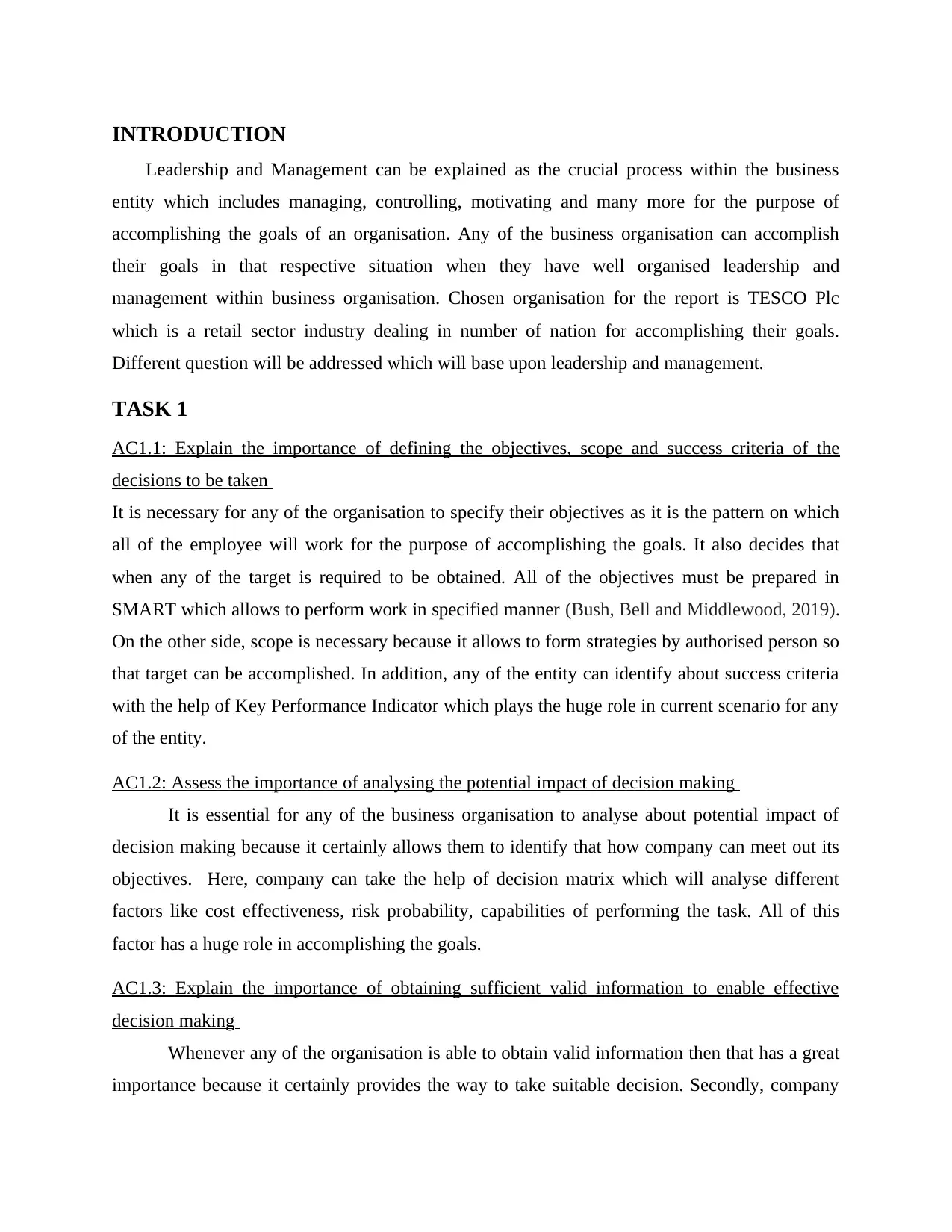
INTRODUCTION
Leadership and Management can be explained as the crucial process within the business
entity which includes managing, controlling, motivating and many more for the purpose of
accomplishing the goals of an organisation. Any of the business organisation can accomplish
their goals in that respective situation when they have well organised leadership and
management within business organisation. Chosen organisation for the report is TESCO Plc
which is a retail sector industry dealing in number of nation for accomplishing their goals.
Different question will be addressed which will base upon leadership and management.
TASK 1
AC1.1: Explain the importance of defining the objectives, scope and success criteria of the
decisions to be taken
It is necessary for any of the organisation to specify their objectives as it is the pattern on which
all of the employee will work for the purpose of accomplishing the goals. It also decides that
when any of the target is required to be obtained. All of the objectives must be prepared in
SMART which allows to perform work in specified manner (Bush, Bell and Middlewood, 2019).
On the other side, scope is necessary because it allows to form strategies by authorised person so
that target can be accomplished. In addition, any of the entity can identify about success criteria
with the help of Key Performance Indicator which plays the huge role in current scenario for any
of the entity.
AC1.2: Assess the importance of analysing the potential impact of decision making
It is essential for any of the business organisation to analyse about potential impact of
decision making because it certainly allows them to identify that how company can meet out its
objectives. Here, company can take the help of decision matrix which will analyse different
factors like cost effectiveness, risk probability, capabilities of performing the task. All of this
factor has a huge role in accomplishing the goals.
AC1.3: Explain the importance of obtaining sufficient valid information to enable effective
decision making
Whenever any of the organisation is able to obtain valid information then that has a great
importance because it certainly provides the way to take suitable decision. Secondly, company
Leadership and Management can be explained as the crucial process within the business
entity which includes managing, controlling, motivating and many more for the purpose of
accomplishing the goals of an organisation. Any of the business organisation can accomplish
their goals in that respective situation when they have well organised leadership and
management within business organisation. Chosen organisation for the report is TESCO Plc
which is a retail sector industry dealing in number of nation for accomplishing their goals.
Different question will be addressed which will base upon leadership and management.
TASK 1
AC1.1: Explain the importance of defining the objectives, scope and success criteria of the
decisions to be taken
It is necessary for any of the organisation to specify their objectives as it is the pattern on which
all of the employee will work for the purpose of accomplishing the goals. It also decides that
when any of the target is required to be obtained. All of the objectives must be prepared in
SMART which allows to perform work in specified manner (Bush, Bell and Middlewood, 2019).
On the other side, scope is necessary because it allows to form strategies by authorised person so
that target can be accomplished. In addition, any of the entity can identify about success criteria
with the help of Key Performance Indicator which plays the huge role in current scenario for any
of the entity.
AC1.2: Assess the importance of analysing the potential impact of decision making
It is essential for any of the business organisation to analyse about potential impact of
decision making because it certainly allows them to identify that how company can meet out its
objectives. Here, company can take the help of decision matrix which will analyse different
factors like cost effectiveness, risk probability, capabilities of performing the task. All of this
factor has a huge role in accomplishing the goals.
AC1.3: Explain the importance of obtaining sufficient valid information to enable effective
decision making
Whenever any of the organisation is able to obtain valid information then that has a great
importance because it certainly provides the way to take suitable decision. Secondly, company
Paraphrase This Document
Need a fresh take? Get an instant paraphrase of this document with our AI Paraphraser
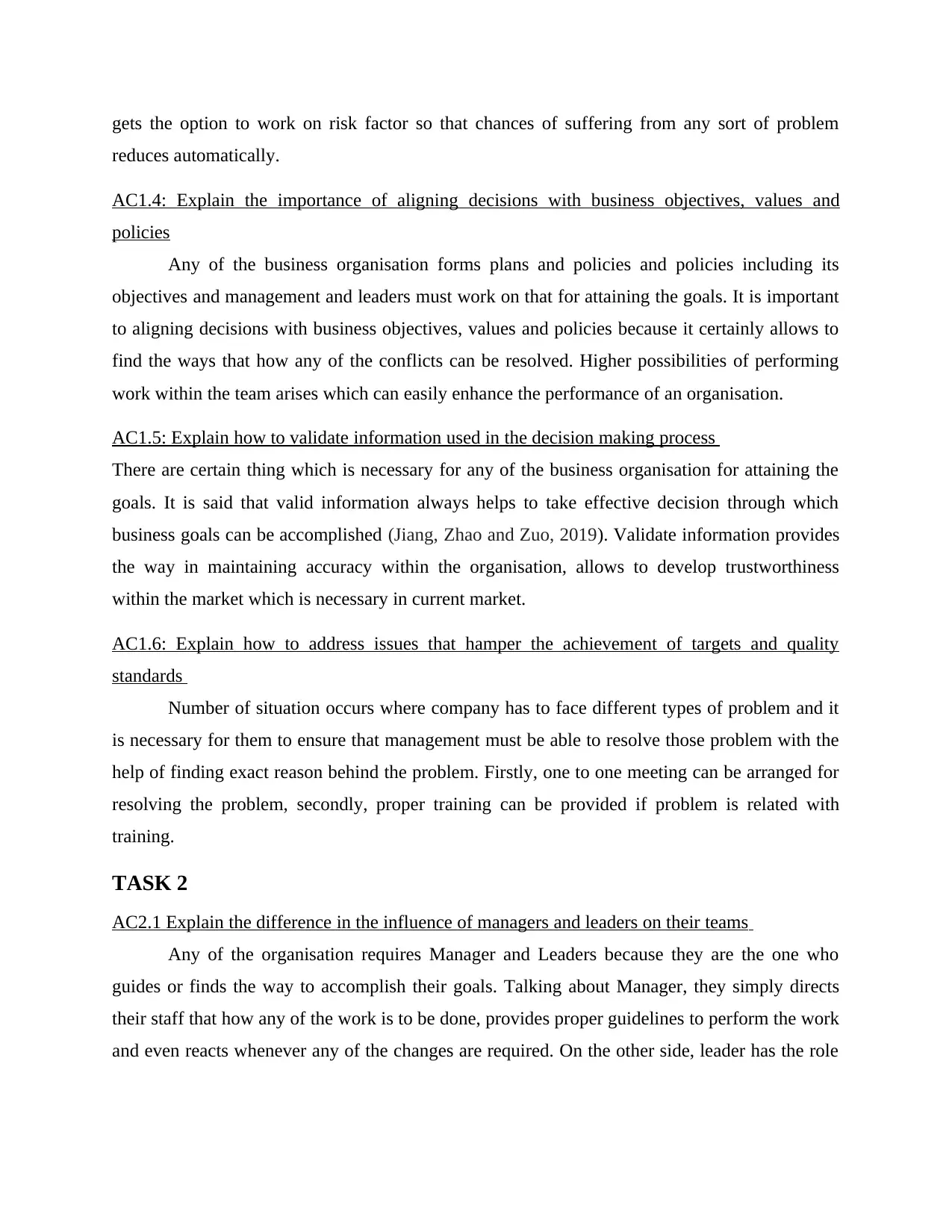
gets the option to work on risk factor so that chances of suffering from any sort of problem
reduces automatically.
AC1.4: Explain the importance of aligning decisions with business objectives, values and
policies
Any of the business organisation forms plans and policies and policies including its
objectives and management and leaders must work on that for attaining the goals. It is important
to aligning decisions with business objectives, values and policies because it certainly allows to
find the ways that how any of the conflicts can be resolved. Higher possibilities of performing
work within the team arises which can easily enhance the performance of an organisation.
AC1.5: Explain how to validate information used in the decision making process
There are certain thing which is necessary for any of the business organisation for attaining the
goals. It is said that valid information always helps to take effective decision through which
business goals can be accomplished (Jiang, Zhao and Zuo, 2019). Validate information provides
the way in maintaining accuracy within the organisation, allows to develop trustworthiness
within the market which is necessary in current market.
AC1.6: Explain how to address issues that hamper the achievement of targets and quality
standards
Number of situation occurs where company has to face different types of problem and it
is necessary for them to ensure that management must be able to resolve those problem with the
help of finding exact reason behind the problem. Firstly, one to one meeting can be arranged for
resolving the problem, secondly, proper training can be provided if problem is related with
training.
TASK 2
AC2.1 Explain the difference in the influence of managers and leaders on their teams
Any of the organisation requires Manager and Leaders because they are the one who
guides or finds the way to accomplish their goals. Talking about Manager, they simply directs
their staff that how any of the work is to be done, provides proper guidelines to perform the work
and even reacts whenever any of the changes are required. On the other side, leader has the role
reduces automatically.
AC1.4: Explain the importance of aligning decisions with business objectives, values and
policies
Any of the business organisation forms plans and policies and policies including its
objectives and management and leaders must work on that for attaining the goals. It is important
to aligning decisions with business objectives, values and policies because it certainly allows to
find the ways that how any of the conflicts can be resolved. Higher possibilities of performing
work within the team arises which can easily enhance the performance of an organisation.
AC1.5: Explain how to validate information used in the decision making process
There are certain thing which is necessary for any of the business organisation for attaining the
goals. It is said that valid information always helps to take effective decision through which
business goals can be accomplished (Jiang, Zhao and Zuo, 2019). Validate information provides
the way in maintaining accuracy within the organisation, allows to develop trustworthiness
within the market which is necessary in current market.
AC1.6: Explain how to address issues that hamper the achievement of targets and quality
standards
Number of situation occurs where company has to face different types of problem and it
is necessary for them to ensure that management must be able to resolve those problem with the
help of finding exact reason behind the problem. Firstly, one to one meeting can be arranged for
resolving the problem, secondly, proper training can be provided if problem is related with
training.
TASK 2
AC2.1 Explain the difference in the influence of managers and leaders on their teams
Any of the organisation requires Manager and Leaders because they are the one who
guides or finds the way to accomplish their goals. Talking about Manager, they simply directs
their staff that how any of the work is to be done, provides proper guidelines to perform the work
and even reacts whenever any of the changes are required. On the other side, leader has the role
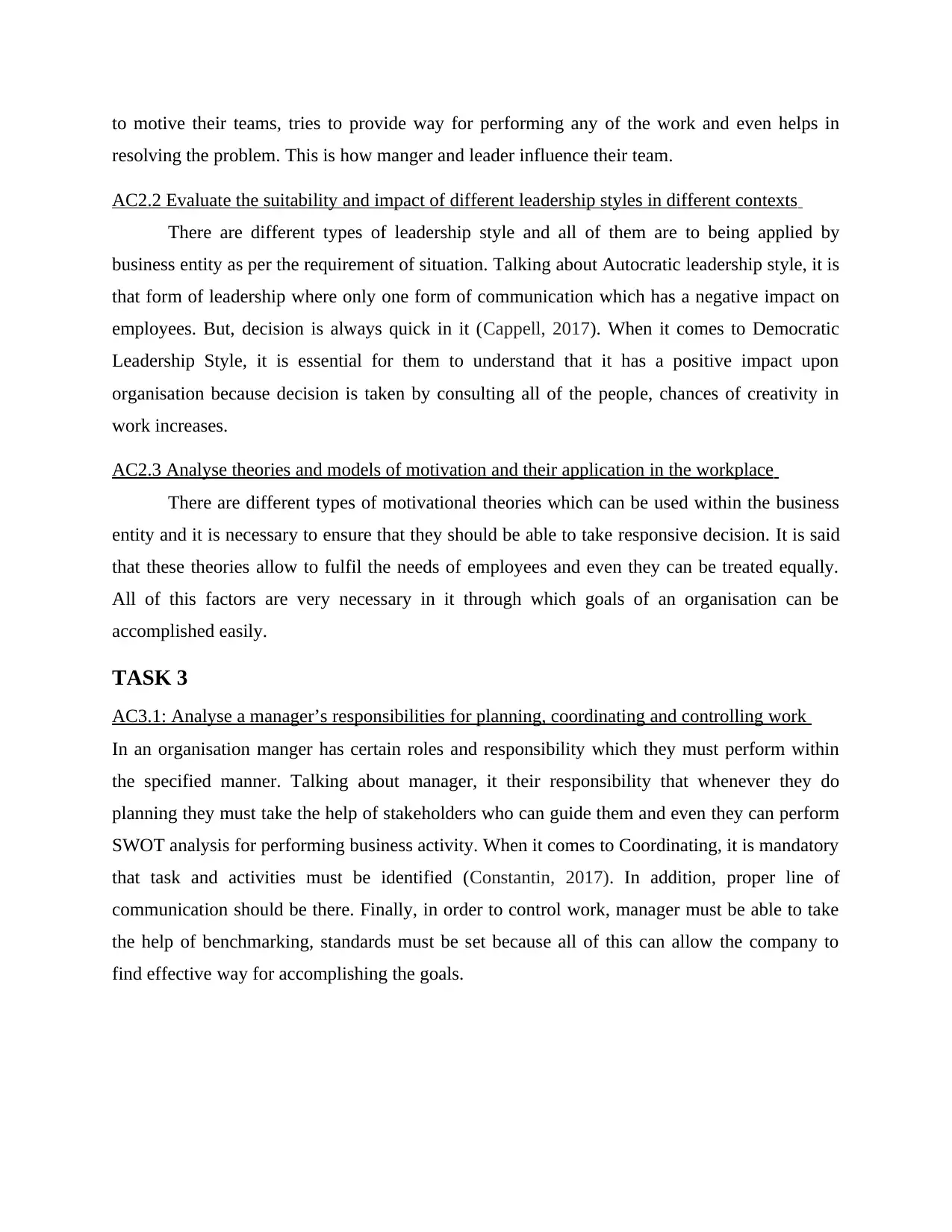
to motive their teams, tries to provide way for performing any of the work and even helps in
resolving the problem. This is how manger and leader influence their team.
AC2.2 Evaluate the suitability and impact of different leadership styles in different contexts
There are different types of leadership style and all of them are to being applied by
business entity as per the requirement of situation. Talking about Autocratic leadership style, it is
that form of leadership where only one form of communication which has a negative impact on
employees. But, decision is always quick in it (Cappell, 2017). When it comes to Democratic
Leadership Style, it is essential for them to understand that it has a positive impact upon
organisation because decision is taken by consulting all of the people, chances of creativity in
work increases.
AC2.3 Analyse theories and models of motivation and their application in the workplace
There are different types of motivational theories which can be used within the business
entity and it is necessary to ensure that they should be able to take responsive decision. It is said
that these theories allow to fulfil the needs of employees and even they can be treated equally.
All of this factors are very necessary in it through which goals of an organisation can be
accomplished easily.
TASK 3
AC3.1: Analyse a manager’s responsibilities for planning, coordinating and controlling work
In an organisation manger has certain roles and responsibility which they must perform within
the specified manner. Talking about manager, it their responsibility that whenever they do
planning they must take the help of stakeholders who can guide them and even they can perform
SWOT analysis for performing business activity. When it comes to Coordinating, it is mandatory
that task and activities must be identified (Constantin, 2017). In addition, proper line of
communication should be there. Finally, in order to control work, manager must be able to take
the help of benchmarking, standards must be set because all of this can allow the company to
find effective way for accomplishing the goals.
resolving the problem. This is how manger and leader influence their team.
AC2.2 Evaluate the suitability and impact of different leadership styles in different contexts
There are different types of leadership style and all of them are to being applied by
business entity as per the requirement of situation. Talking about Autocratic leadership style, it is
that form of leadership where only one form of communication which has a negative impact on
employees. But, decision is always quick in it (Cappell, 2017). When it comes to Democratic
Leadership Style, it is essential for them to understand that it has a positive impact upon
organisation because decision is taken by consulting all of the people, chances of creativity in
work increases.
AC2.3 Analyse theories and models of motivation and their application in the workplace
There are different types of motivational theories which can be used within the business
entity and it is necessary to ensure that they should be able to take responsive decision. It is said
that these theories allow to fulfil the needs of employees and even they can be treated equally.
All of this factors are very necessary in it through which goals of an organisation can be
accomplished easily.
TASK 3
AC3.1: Analyse a manager’s responsibilities for planning, coordinating and controlling work
In an organisation manger has certain roles and responsibility which they must perform within
the specified manner. Talking about manager, it their responsibility that whenever they do
planning they must take the help of stakeholders who can guide them and even they can perform
SWOT analysis for performing business activity. When it comes to Coordinating, it is mandatory
that task and activities must be identified (Constantin, 2017). In addition, proper line of
communication should be there. Finally, in order to control work, manager must be able to take
the help of benchmarking, standards must be set because all of this can allow the company to
find effective way for accomplishing the goals.
⊘ This is a preview!⊘
Do you want full access?
Subscribe today to unlock all pages.

Trusted by 1+ million students worldwide
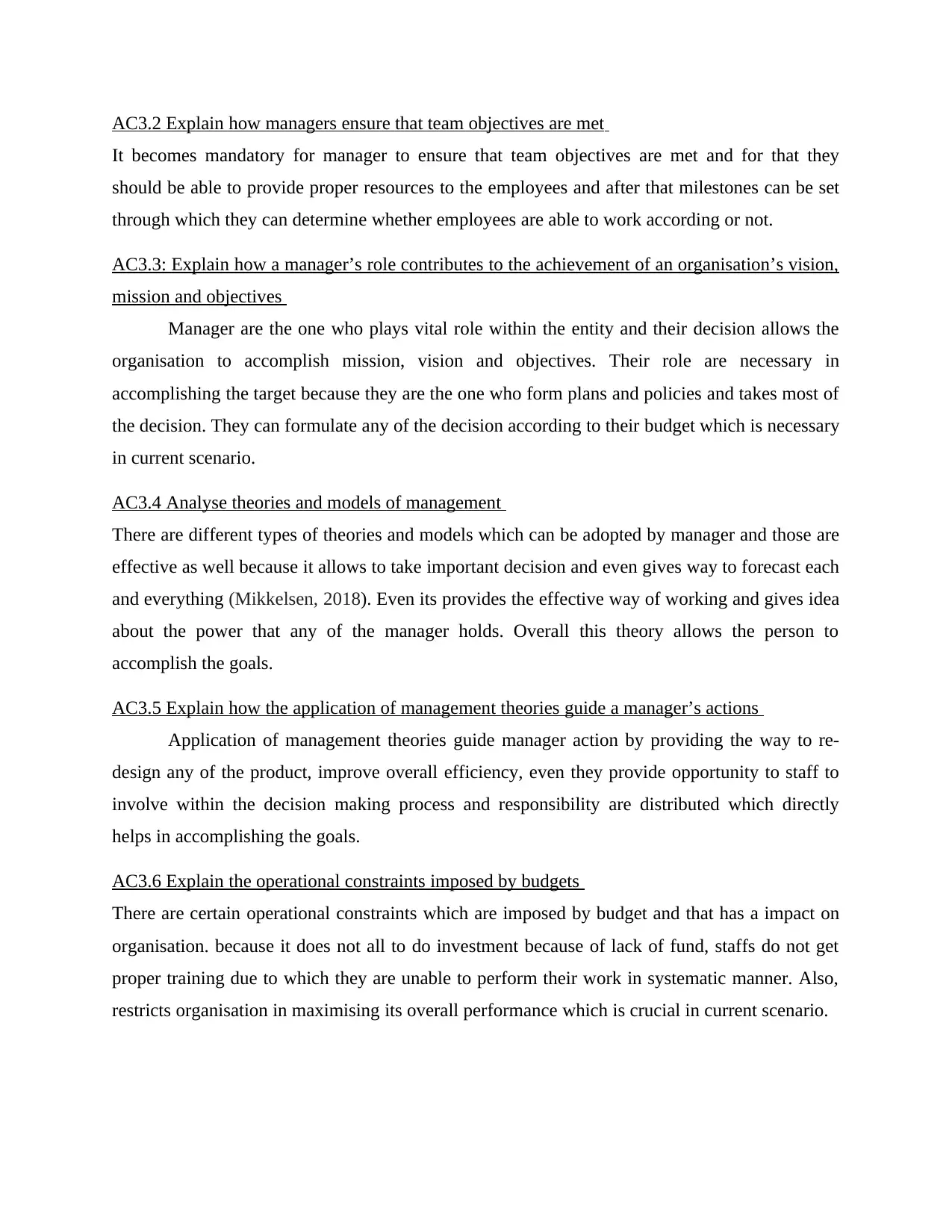
AC3.2 Explain how managers ensure that team objectives are met
It becomes mandatory for manager to ensure that team objectives are met and for that they
should be able to provide proper resources to the employees and after that milestones can be set
through which they can determine whether employees are able to work according or not.
AC3.3: Explain how a manager’s role contributes to the achievement of an organisation’s vision,
mission and objectives
Manager are the one who plays vital role within the entity and their decision allows the
organisation to accomplish mission, vision and objectives. Their role are necessary in
accomplishing the target because they are the one who form plans and policies and takes most of
the decision. They can formulate any of the decision according to their budget which is necessary
in current scenario.
AC3.4 Analyse theories and models of management
There are different types of theories and models which can be adopted by manager and those are
effective as well because it allows to take important decision and even gives way to forecast each
and everything (Mikkelsen, 2018). Even its provides the effective way of working and gives idea
about the power that any of the manager holds. Overall this theory allows the person to
accomplish the goals.
AC3.5 Explain how the application of management theories guide a manager’s actions
Application of management theories guide manager action by providing the way to re-
design any of the product, improve overall efficiency, even they provide opportunity to staff to
involve within the decision making process and responsibility are distributed which directly
helps in accomplishing the goals.
AC3.6 Explain the operational constraints imposed by budgets
There are certain operational constraints which are imposed by budget and that has a impact on
organisation. because it does not all to do investment because of lack of fund, staffs do not get
proper training due to which they are unable to perform their work in systematic manner. Also,
restricts organisation in maximising its overall performance which is crucial in current scenario.
It becomes mandatory for manager to ensure that team objectives are met and for that they
should be able to provide proper resources to the employees and after that milestones can be set
through which they can determine whether employees are able to work according or not.
AC3.3: Explain how a manager’s role contributes to the achievement of an organisation’s vision,
mission and objectives
Manager are the one who plays vital role within the entity and their decision allows the
organisation to accomplish mission, vision and objectives. Their role are necessary in
accomplishing the target because they are the one who form plans and policies and takes most of
the decision. They can formulate any of the decision according to their budget which is necessary
in current scenario.
AC3.4 Analyse theories and models of management
There are different types of theories and models which can be adopted by manager and those are
effective as well because it allows to take important decision and even gives way to forecast each
and everything (Mikkelsen, 2018). Even its provides the effective way of working and gives idea
about the power that any of the manager holds. Overall this theory allows the person to
accomplish the goals.
AC3.5 Explain how the application of management theories guide a manager’s actions
Application of management theories guide manager action by providing the way to re-
design any of the product, improve overall efficiency, even they provide opportunity to staff to
involve within the decision making process and responsibility are distributed which directly
helps in accomplishing the goals.
AC3.6 Explain the operational constraints imposed by budgets
There are certain operational constraints which are imposed by budget and that has a impact on
organisation. because it does not all to do investment because of lack of fund, staffs do not get
proper training due to which they are unable to perform their work in systematic manner. Also,
restricts organisation in maximising its overall performance which is crucial in current scenario.
Paraphrase This Document
Need a fresh take? Get an instant paraphrase of this document with our AI Paraphraser
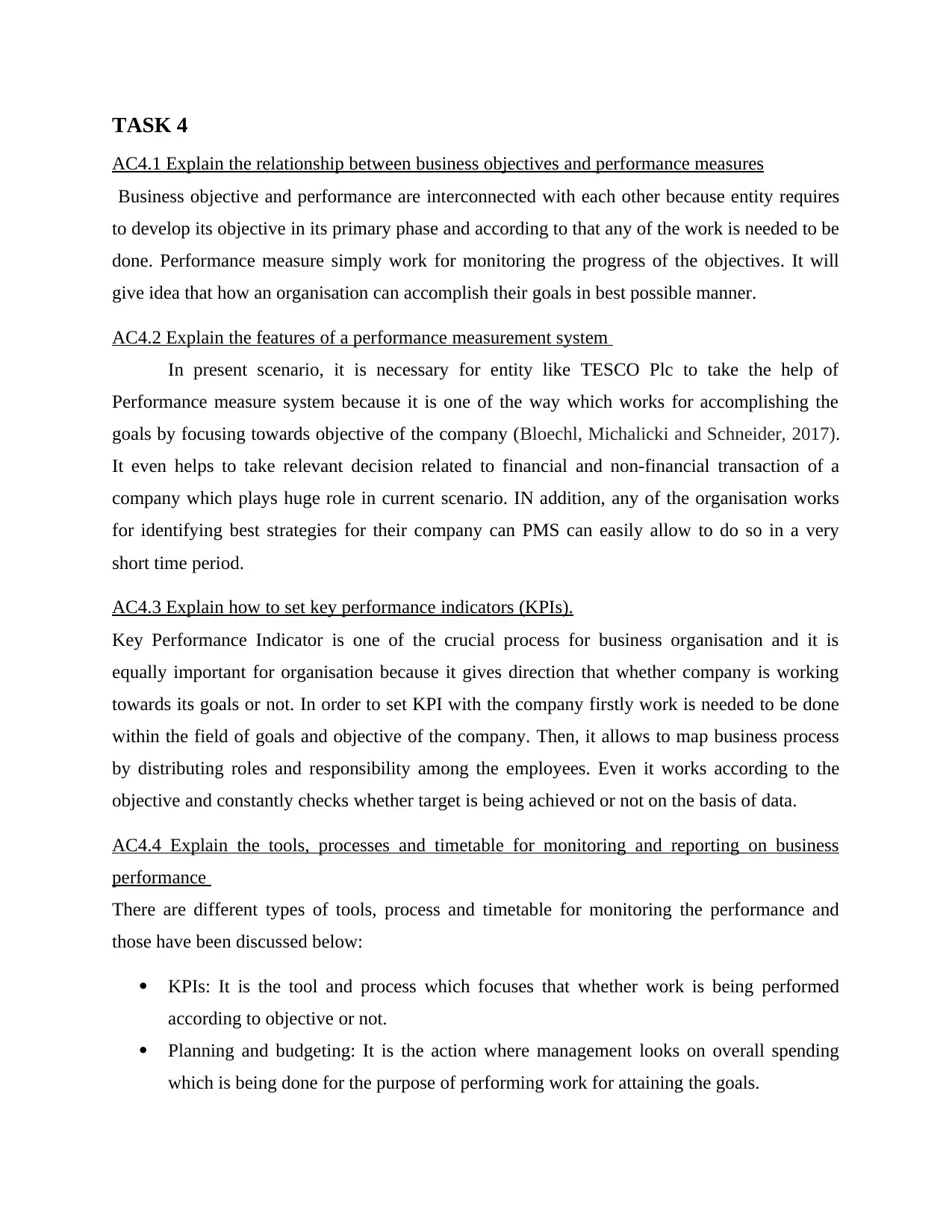
TASK 4
AC4.1 Explain the relationship between business objectives and performance measures
Business objective and performance are interconnected with each other because entity requires
to develop its objective in its primary phase and according to that any of the work is needed to be
done. Performance measure simply work for monitoring the progress of the objectives. It will
give idea that how an organisation can accomplish their goals in best possible manner.
AC4.2 Explain the features of a performance measurement system
In present scenario, it is necessary for entity like TESCO Plc to take the help of
Performance measure system because it is one of the way which works for accomplishing the
goals by focusing towards objective of the company (Bloechl, Michalicki and Schneider, 2017).
It even helps to take relevant decision related to financial and non-financial transaction of a
company which plays huge role in current scenario. IN addition, any of the organisation works
for identifying best strategies for their company can PMS can easily allow to do so in a very
short time period.
AC4.3 Explain how to set key performance indicators (KPIs).
Key Performance Indicator is one of the crucial process for business organisation and it is
equally important for organisation because it gives direction that whether company is working
towards its goals or not. In order to set KPI with the company firstly work is needed to be done
within the field of goals and objective of the company. Then, it allows to map business process
by distributing roles and responsibility among the employees. Even it works according to the
objective and constantly checks whether target is being achieved or not on the basis of data.
AC4.4 Explain the tools, processes and timetable for monitoring and reporting on business
performance
There are different types of tools, process and timetable for monitoring the performance and
those have been discussed below:
KPIs: It is the tool and process which focuses that whether work is being performed
according to objective or not.
Planning and budgeting: It is the action where management looks on overall spending
which is being done for the purpose of performing work for attaining the goals.
AC4.1 Explain the relationship between business objectives and performance measures
Business objective and performance are interconnected with each other because entity requires
to develop its objective in its primary phase and according to that any of the work is needed to be
done. Performance measure simply work for monitoring the progress of the objectives. It will
give idea that how an organisation can accomplish their goals in best possible manner.
AC4.2 Explain the features of a performance measurement system
In present scenario, it is necessary for entity like TESCO Plc to take the help of
Performance measure system because it is one of the way which works for accomplishing the
goals by focusing towards objective of the company (Bloechl, Michalicki and Schneider, 2017).
It even helps to take relevant decision related to financial and non-financial transaction of a
company which plays huge role in current scenario. IN addition, any of the organisation works
for identifying best strategies for their company can PMS can easily allow to do so in a very
short time period.
AC4.3 Explain how to set key performance indicators (KPIs).
Key Performance Indicator is one of the crucial process for business organisation and it is
equally important for organisation because it gives direction that whether company is working
towards its goals or not. In order to set KPI with the company firstly work is needed to be done
within the field of goals and objective of the company. Then, it allows to map business process
by distributing roles and responsibility among the employees. Even it works according to the
objective and constantly checks whether target is being achieved or not on the basis of data.
AC4.4 Explain the tools, processes and timetable for monitoring and reporting on business
performance
There are different types of tools, process and timetable for monitoring the performance and
those have been discussed below:
KPIs: It is the tool and process which focuses that whether work is being performed
according to objective or not.
Planning and budgeting: It is the action where management looks on overall spending
which is being done for the purpose of performing work for attaining the goals.
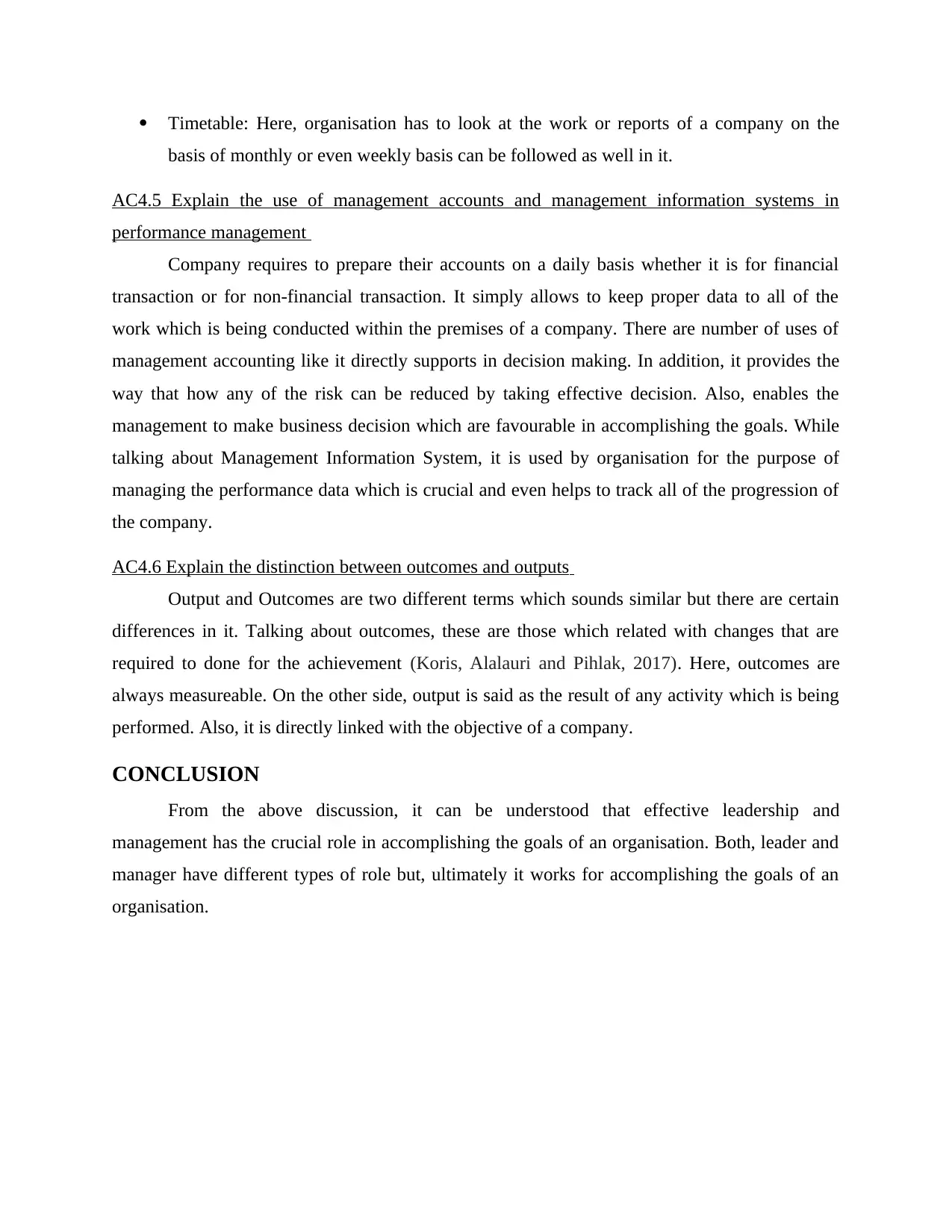
Timetable: Here, organisation has to look at the work or reports of a company on the
basis of monthly or even weekly basis can be followed as well in it.
AC4.5 Explain the use of management accounts and management information systems in
performance management
Company requires to prepare their accounts on a daily basis whether it is for financial
transaction or for non-financial transaction. It simply allows to keep proper data to all of the
work which is being conducted within the premises of a company. There are number of uses of
management accounting like it directly supports in decision making. In addition, it provides the
way that how any of the risk can be reduced by taking effective decision. Also, enables the
management to make business decision which are favourable in accomplishing the goals. While
talking about Management Information System, it is used by organisation for the purpose of
managing the performance data which is crucial and even helps to track all of the progression of
the company.
AC4.6 Explain the distinction between outcomes and outputs
Output and Outcomes are two different terms which sounds similar but there are certain
differences in it. Talking about outcomes, these are those which related with changes that are
required to done for the achievement (Koris, Alalauri and Pihlak, 2017). Here, outcomes are
always measureable. On the other side, output is said as the result of any activity which is being
performed. Also, it is directly linked with the objective of a company.
CONCLUSION
From the above discussion, it can be understood that effective leadership and
management has the crucial role in accomplishing the goals of an organisation. Both, leader and
manager have different types of role but, ultimately it works for accomplishing the goals of an
organisation.
basis of monthly or even weekly basis can be followed as well in it.
AC4.5 Explain the use of management accounts and management information systems in
performance management
Company requires to prepare their accounts on a daily basis whether it is for financial
transaction or for non-financial transaction. It simply allows to keep proper data to all of the
work which is being conducted within the premises of a company. There are number of uses of
management accounting like it directly supports in decision making. In addition, it provides the
way that how any of the risk can be reduced by taking effective decision. Also, enables the
management to make business decision which are favourable in accomplishing the goals. While
talking about Management Information System, it is used by organisation for the purpose of
managing the performance data which is crucial and even helps to track all of the progression of
the company.
AC4.6 Explain the distinction between outcomes and outputs
Output and Outcomes are two different terms which sounds similar but there are certain
differences in it. Talking about outcomes, these are those which related with changes that are
required to done for the achievement (Koris, Alalauri and Pihlak, 2017). Here, outcomes are
always measureable. On the other side, output is said as the result of any activity which is being
performed. Also, it is directly linked with the objective of a company.
CONCLUSION
From the above discussion, it can be understood that effective leadership and
management has the crucial role in accomplishing the goals of an organisation. Both, leader and
manager have different types of role but, ultimately it works for accomplishing the goals of an
organisation.
⊘ This is a preview!⊘
Do you want full access?
Subscribe today to unlock all pages.

Trusted by 1+ million students worldwide
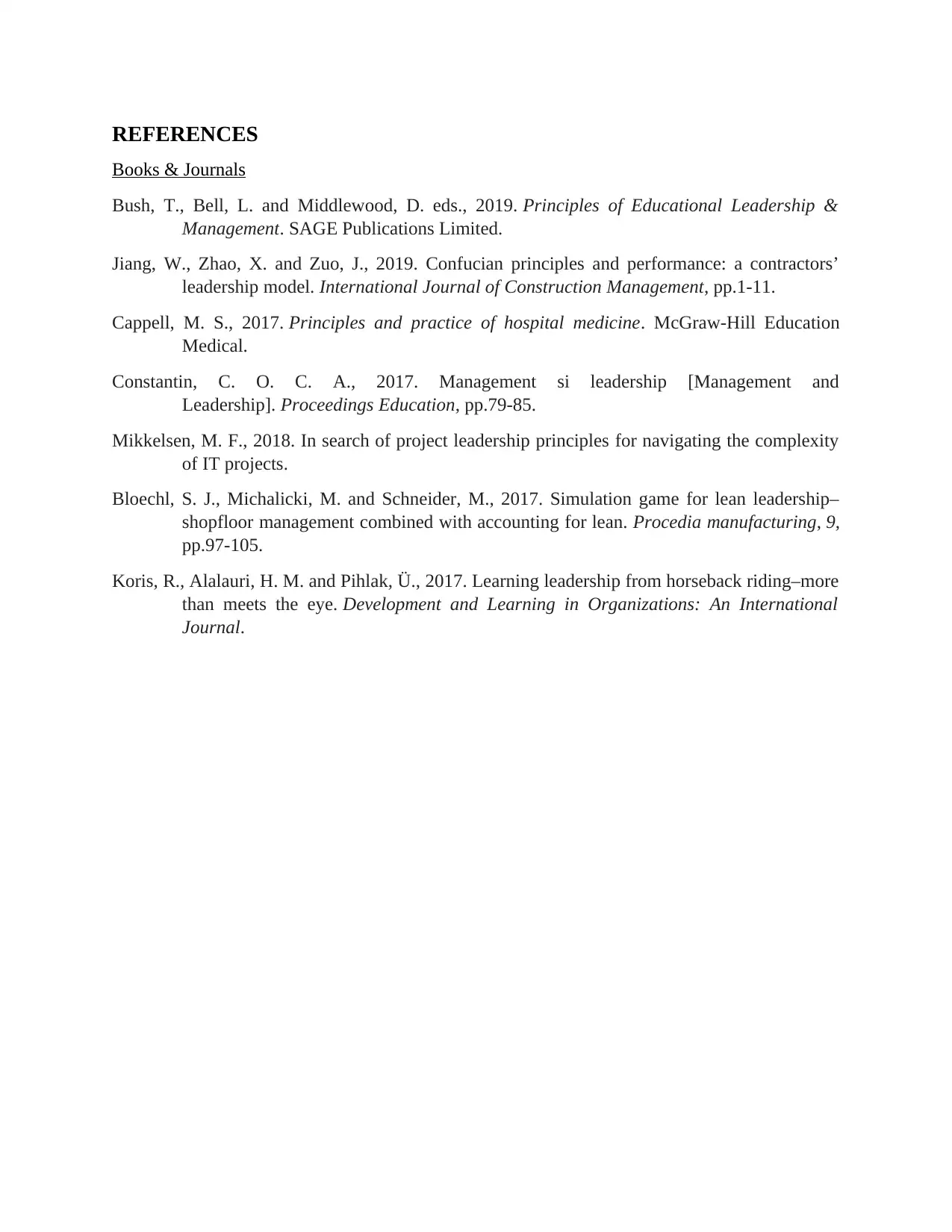
REFERENCES
Books & Journals
Bush, T., Bell, L. and Middlewood, D. eds., 2019. Principles of Educational Leadership &
Management. SAGE Publications Limited.
Jiang, W., Zhao, X. and Zuo, J., 2019. Confucian principles and performance: a contractors’
leadership model. International Journal of Construction Management, pp.1-11.
Cappell, M. S., 2017. Principles and practice of hospital medicine. McGraw-Hill Education
Medical.
Constantin, C. O. C. A., 2017. Management si leadership [Management and
Leadership]. Proceedings Education, pp.79-85.
Mikkelsen, M. F., 2018. In search of project leadership principles for navigating the complexity
of IT projects.
Bloechl, S. J., Michalicki, M. and Schneider, M., 2017. Simulation game for lean leadership–
shopfloor management combined with accounting for lean. Procedia manufacturing, 9,
pp.97-105.
Koris, R., Alalauri, H. M. and Pihlak, Ü., 2017. Learning leadership from horseback riding–more
than meets the eye. Development and Learning in Organizations: An International
Journal.
Books & Journals
Bush, T., Bell, L. and Middlewood, D. eds., 2019. Principles of Educational Leadership &
Management. SAGE Publications Limited.
Jiang, W., Zhao, X. and Zuo, J., 2019. Confucian principles and performance: a contractors’
leadership model. International Journal of Construction Management, pp.1-11.
Cappell, M. S., 2017. Principles and practice of hospital medicine. McGraw-Hill Education
Medical.
Constantin, C. O. C. A., 2017. Management si leadership [Management and
Leadership]. Proceedings Education, pp.79-85.
Mikkelsen, M. F., 2018. In search of project leadership principles for navigating the complexity
of IT projects.
Bloechl, S. J., Michalicki, M. and Schneider, M., 2017. Simulation game for lean leadership–
shopfloor management combined with accounting for lean. Procedia manufacturing, 9,
pp.97-105.
Koris, R., Alalauri, H. M. and Pihlak, Ü., 2017. Learning leadership from horseback riding–more
than meets the eye. Development and Learning in Organizations: An International
Journal.
1 out of 10
Related Documents
Your All-in-One AI-Powered Toolkit for Academic Success.
+13062052269
info@desklib.com
Available 24*7 on WhatsApp / Email
![[object Object]](/_next/static/media/star-bottom.7253800d.svg)
Unlock your academic potential
Copyright © 2020–2025 A2Z Services. All Rights Reserved. Developed and managed by ZUCOL.




